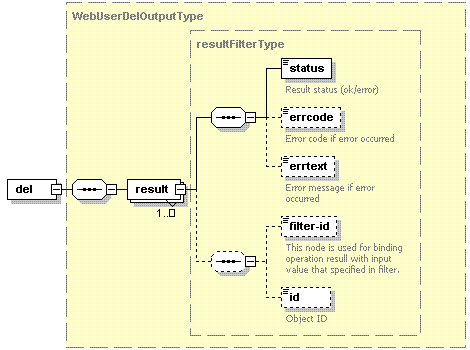Deleting Web Users
Use the del operation to remove one or more web users from the site.
Request Packet Structure
A request XML packet removing a web user includes the del operation node:
<packet version="1.4.2.0">
<webuser >
<del>
...
</del>
</webuser>
</packet>
The del node is presented by type WebUserDelInputType (webuser.xsd), and its graphical representation is as follows:

- The filter node is required. It specifies a filtering rule. For more information, refer to the Available Filters section. Data type: WebUserFilter (
webuser.xsd)
Remarks
You can remove multiple web users using different filtering rules in a single packet. Add as many del operations as the number of different filtering rules to be used.
<packet version="1.6.3.0">
<del>
...
</del>
...
<del>
...
</del>
</packet>
Response Packet Structure
The del node of the output XML packet is presented by type WebUserDelOutputType (webuser.xsd) and structured as follows:

- The result node is required. It wraps the response retrieved from the server. Data type: resultFilterType (
common.xsd). - The status node is required. It specifies the execution status of the del operation. Data type: string. Allowed values: ok | error.
- The errcode node is optional. It returns the error code if the del operation fails. Data type: unsignedInt.
- The errcode node is optional. It returns the error code if the del operation fails. Data type: unsignedInt.
- The errtext node is optional. It returns the error message if the del operation fails. Data type: string.
- The filter-id node is required. It returns the filtering rule parameter. For more information, refer to the Available Filters section. Data type:anySimpleType.
- The id node is optional. If the del operation succeeds it holds the ID of the deleted web user. Data type: integer.
Samples
Deleting a web user
Send the following request to delete the web user identified by login name AbCdEf.
<packet>
<webuser>
<del>
<filter>
<login>AbCdEf</login>
</filter>
</del>
</webuser>
</packet>Response:
<packet>
<webuser>
<del>
<result>
<status>ok</status>
<filter-id>AbCdEf</filter-id>
<id>253</id>
</result>
</del>
</webuser>
</packet>
A negative response from the server can look as follows:
<packet>
<webuser>
<del>
<result>
<status>error</status>
<errcode>1013</errcode>
<errtext>Web user does not exist.</errtext>
<filter-id>AbCdEf</filter-id>
</result>
</del>
</webuser>
</packet> Deleting multiple web users
The following request removes all web users from example.com and example2.com sites:
<packet>
<webuser>
<del>
<filter>
<site-name>example.com</site-name>
<site-name>example2.com</site-name>
</filter>
</del>
</webuser>
</packet>Response (if two web users on example.com were deleted and example2.com was not found on the server):
<packet>
<webuser>
<del>
<result>
<status>ok</status>
<filter-id>example.com</filter-id>
<id>156</id>
</result>
<result>
<status>ok</status>
<filter-id>example.com</filter-id>
<id>157</id>
</result>
<result>
<status>error</status>
<errcode>1015</errcode>
<errtext>Domain name does not exist</errtext>
<filter-id>example2.com</filter-id>
</result>
</del>
</webuser>
</packet>